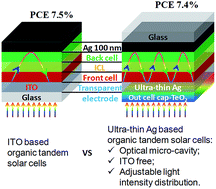Manipulation of optical field distribution in ITO-free micro-cavity polymer tandem solar cells via the out-of-cell capping layer for high photovoltaic performance†
Abstract
Series-connected tandem organic photovoltaic devices (SCTOPVs) have been shown to provide higher power conversion efficiencies (PCEs) than the single junction devices due to the improved light harvesting. To achieve the optimal device performance of SCTOPVs, balancing the photocurrents generated from the sub-cells is critical according to the Kirchhoff law. In this work, we demonstrate that the out-of-cell capping layer of an ITO-free microcavity SCTOPV plays an important role in manipulating the optical field distribution in the constituent sub-cells for achieving balanced photocurrents and optimal photovoltaic performance. Two mirror-like electrodes, a semi-transparent ultrathin Ag capped with a dielectric TeO2 layer and a thick Ag electrode were used to construct an ITO-free top-illuminated microcavity configuration, in which certain frequencies of solar irradiance can resonate between the reflective surfaces. As a result, a top-illuminated ITO-free SCTOPV with a comparable performance (7.4%) to the ITO-based counterpart (7.5%) was demonstrated despite the inferior transmittance of the ultra-thin Ag relative to ITO.


 Please wait while we load your content...
Please wait while we load your content...